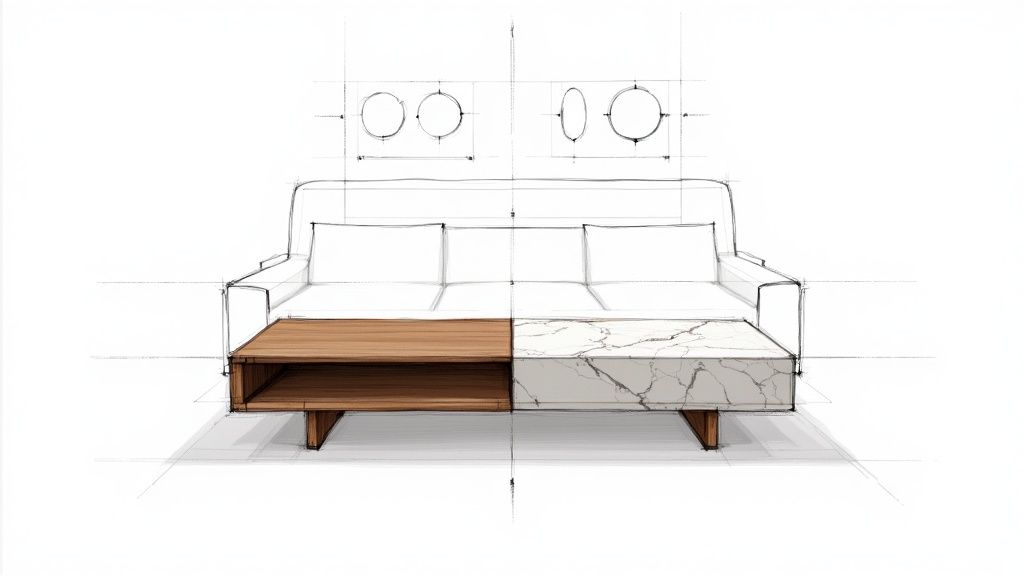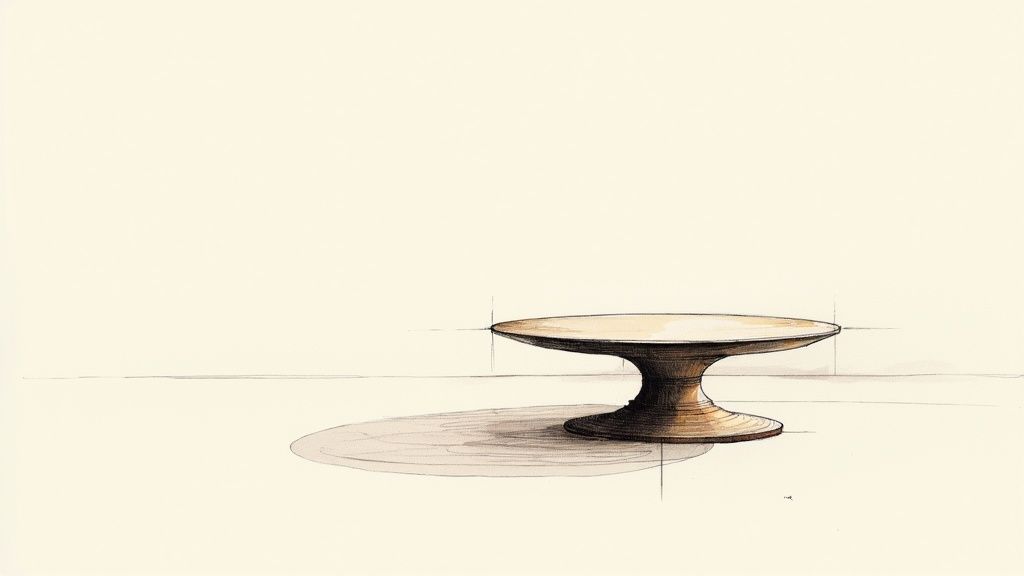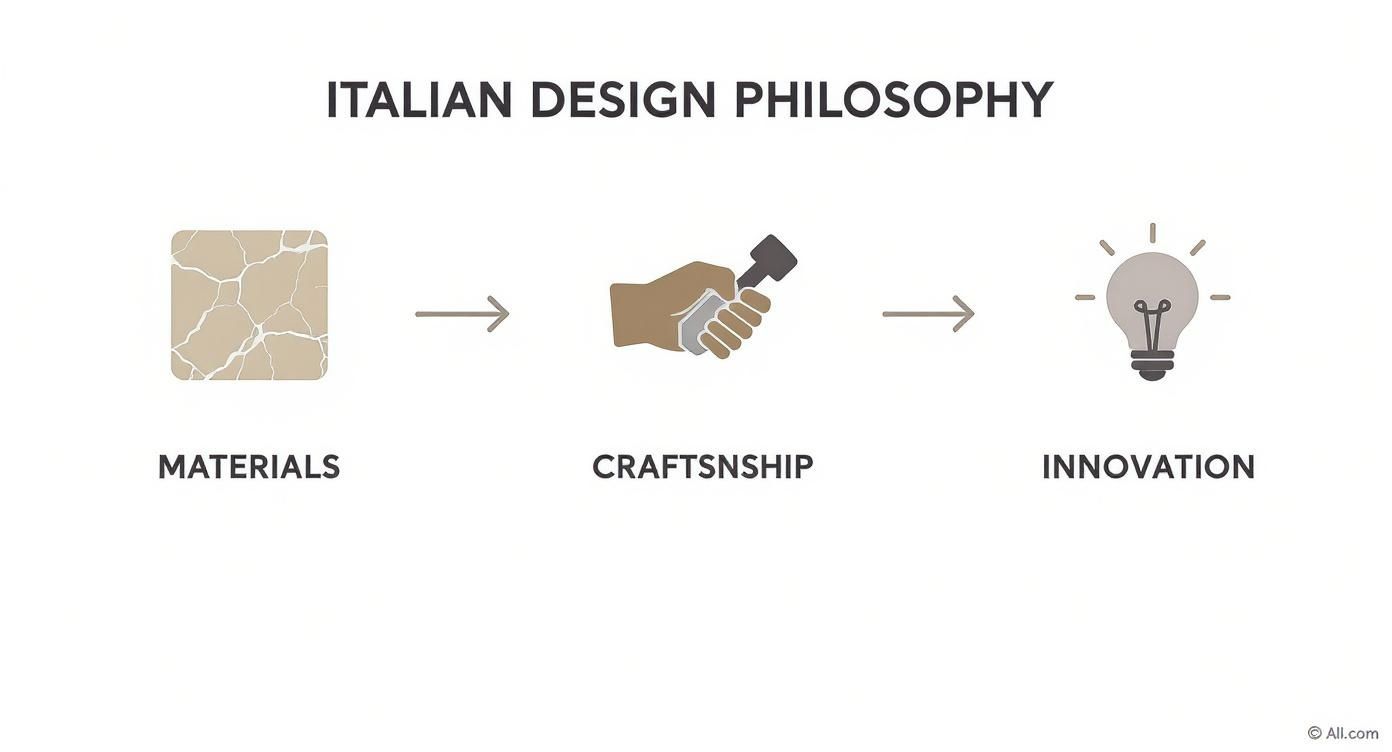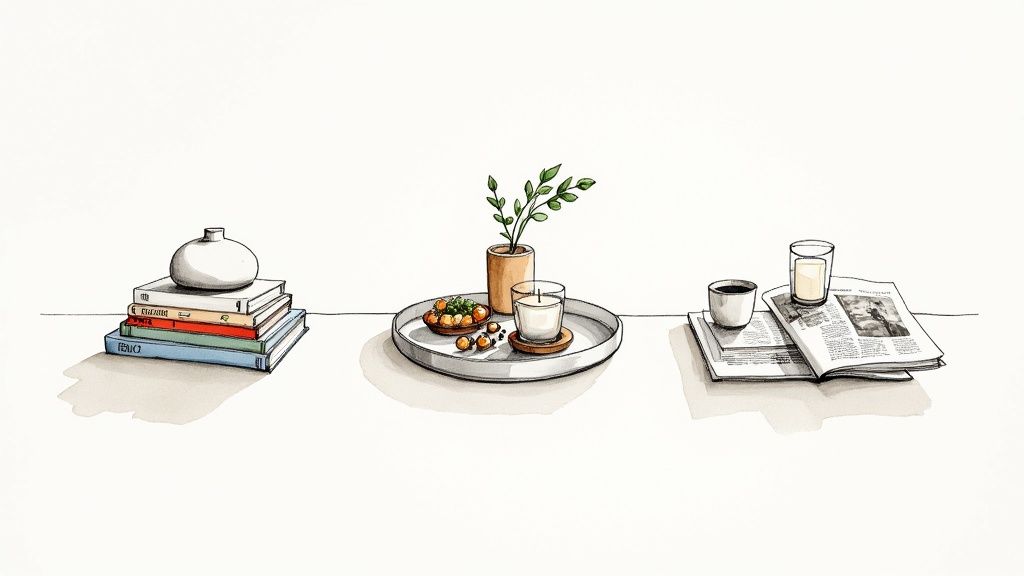
Una guida alla scelta e allo stile dei tavolini da caffè italiani
Nel mondo dell'interior design, alcuni pezzi sono semplicemente mobili, mentre altri sono opere d'arte. I tavolini da caffè italiani rientrano saldamente in quest'ultima categoria. Non sono semplici superfici; sono celebri testimonianze di tradizione, arte e un livello di artigianalità che sembra quasi impossibile trovare altrove.
Questa guida fornisce passaggi pratici per aiutarti a scegliere, posizionare e dare stile al perfetto tavolino da caffè italiano, trasformandolo da un semplice acquisto in un elemento centrale magnetico per il tuo spazio abitativo.
L'arte del tavolino da caffè italiano

Immagina un singolo oggetto nel tuo soggiorno che susciti conversazione e irradi eleganza. Questa è la magia di un autentico tavolino da caffè italiano. Il tuo obiettivo è scegliere un pezzo che faccia più che appoggiare il tuo caffè mattutino o i tuoi libri preferiti: dovrebbe fungere da scultura centrale, ancorando l'intera stanza e parlando a voce alta di un profondo apprezzamento per la bellezza.
Questo impegno per l'eccellenza è parte di una storia molto più ampia. Per generazioni, il design italiano ha definito lo standard globale di qualità, una reputazione costruita da maestri artigiani. Infatti, si prevede che l'intero mercato italiano dell'arredamento raggiungerà la sbalorditiva cifra di 14,99 miliardi di dollari nel 2025, a testimonianza di questa tradizione duratura. Se siete curiosi, potete esplorare ulteriori dati sull'industria italiana dell'arredamento per comprendere la reale portata di questa incredibile maestria artigianale.
Più di un semplice mobile
Scegliere un tavolino da caffè italiano non è solo un acquisto; è un atto deliberato di cura del proprio mondo. Il tuo obiettivo è andare oltre la pura funzionalità e accogliere un oggetto con una vera anima nella tua casa. Questi sono pezzi progettati per essere vissuti, amati e, infine, tramandati, diventando parte tangibile della storia della tua famiglia.
Ciò che li distingue davvero è la filosofia insita nelle loro creazioni. Ogni singola curva, scelta dei materiali e finitura è meticolosamente ponderata per creare un insieme perfettamente armonioso. Questa guida è qui per illustrarvi questa filosofia, aiutandovi a trovare un tavolo che non si limiti a riempire uno spazio, ma lo elevi completamente.
Un tavolino da caffè italiano è la massima espressione della "sprezzatura" nell'arredamento della casa: un'eleganza studiata e spontanea che esprime un messaggio profondo senza mai urlare.
Ecco gli attributi chiave da ricercare quando si sceglie un pezzo:
- Design senza tempo: scegli forme classiche e materiali di alta qualità che non passeranno mai di moda.
- Maestria artigianale: ispeziona i dettagli. Cerca la giunzione impeccabile e le finiture incredibilmente lisce.
- Espressione artistica: non abbiate paura delle forme scultoree. Scegliete un tavolo che sia un'opera d'arte funzionale che catturi immediatamente l'attenzione.
È qui che inizia il nostro viaggio. Scopriamo come portare questo incredibile mix di arte e funzionalità direttamente nel cuore della tua casa.
Cosa rende il design italiano così speciale?
Cosa rende un tavolino italiano così diverso, così... vivo? Non è un singolo elemento, ma una filosofia profondamente intenzionale, un modo di pensare che trasforma l'arredo in arte. Per fare la scelta giusta, è necessario comprendere questo approccio. Si tratta di combinare i migliori ingredienti – materiali, tecniche e un pizzico di genialità – per creare qualcosa di eccezionale.
Al centro c'è un bellissimo concetto italiano chiamato "sprezzatura" . È quest'idea di studiata nonchalance, di far sembrare naturale qualcosa di incredibilmente complesso e magistralmente costruito. Un tavolino da caffè italiano non grida per attirare l'attenzione. Al contrario, cattura l'attenzione di una stanza con la sua tranquilla sicurezza, le proporzioni impeccabili e un senso di semplicità quasi impossibile.
Ecco perché questi pezzi si adattano così bene a uno spazio reale e vissuto. Sono progettati per essere toccati, usati e amati ogni giorno, senza mai sacrificare la funzionalità in nome della loro forma straordinaria.
I tre pilastri del design italiano
Per comprendere appieno cosa rende questi tavolini così eccezionali, è necessario riconoscere i tre pilastri che sostengono ogni progetto. Sono gli elementi imprescindibili da ricercare. Se combinati alla perfezione, creano qualcosa di mozzafiato e allo stesso tempo costruito per durare una vita.
- Un rispetto per i materiali: inizia il tuo processo di selezione concentrandoti sul materiale. Gli artigiani italiani hanno un profondo rispetto per il loro materiale, che si tratti di una lastra mozzafiato di marmo di Carrara, delle calde e profonde venature del noce massello o dell'elegante precisione dell'acciaio. Non si limitano a utilizzare i materiali; li mettono in risalto, lasciandone risplendere la bellezza intrinseca e naturale.
- L'arte dell'artigianato: ora esaminiamo la costruzione. Tecniche antiche, tramandate di generazione in generazione, si fondono con la precisione moderna. Non stiamo parlando di catene di montaggio. Stiamo parlando di un'attenzione meticolosa, quasi ossessiva, a ogni giunzione, ogni bordo e ogni finitura. Quel tocco umano conferisce a ogni pezzo la sua anima.
- Uno spirito di innovazione senza paura: infine, apprezzate la visione del design. Pur essendo profondamente radicato nella tradizione, il design italiano è sempre proiettato verso il futuro. I designer non hanno paura di sperimentare nuove forme, di spingersi oltre i limiti di un materiale o di reinventare completamente una forma classica per il mondo di oggi. Ecco perché un tavolo può sembrare antico e allo stesso tempo nuovo.
Il vero design italiano è un dialogo tra passato e futuro. Onora la storia rifiutandosi di ripeterla e creando pezzi che siano al tempo stesso classici e attuali.
Vedere la filosofia in azione
Come si traduce tutto questo in quel meraviglioso tavolo al centro del tuo soggiorno? Significa che ogni singola scelta è fatta con uno scopo preciso. Un designer potrebbe mettere a contrasto un piano in travertino grezzo e terroso con una base in metallo sottilissimo, creando questo incredibile dialogo tra naturale e artificiale. Questa è la sprezzatura: due idee diverse che si uniscono per creare qualcosa di incredibilmente chic e completamente naturale.
In definitiva, l'obiettivo è scegliere un pezzo che susciti una risposta emotiva. È nel modo in cui la luce gioca su una superficie lucida o nella sensazione di un bordo di legno perfettamente levigato sotto la punta delle dita. È un invito a entrare in contatto con l'oggetto, non solo a guardarlo. Questo approccio ponderato è un pilastro dell'arredamento italiano moderno .
Un tavolino da caffè italiano non è mai solo una superficie su cui appoggiare il telecomando. È il cuore del tuo spazio abitativo, un promemoria quotidiano di qualità duratura e una silenziosa fonte di ispirazione. È un investimento in una bellezza con cui puoi vivere ogni singolo giorno.
Scegliere il materiale della tua firma
L'anima di un tavolino italiano risiede davvero nel suo materiale. È qui che inizia la storia, dove la bellezza grezza e naturale incontra la visione di un artigiano. Scegliere il materiale giusto è come scegliere l'attore principale per il tuo soggiorno. Ognuno di essi conferisce una personalità distinta, un'energia unica e una resa completamente diversa allo spazio.
Questa è più di una decisione pratica; è una decisione emotiva. Siete attratti dalla storia antica e suggestiva raccontata dalle venature sinuose del marmo? O forse la presenza silenziosa e rassicurante del legno massello vi parla di più. Immergiamoci nei materiali distintivi che definiscono il design italiano e troviamo quello che si adatta perfettamente alla vostra casa e al vostro spirito.
Questa immagine offre una fantastica panoramica del funzionamento del design italiano, mostrando la splendida interazione tra materiali, artigianato e innovazione.

Come puoi vedere, il pezzo finale è una perfetta armonia di tutti e tre, ma la scelta del materiale è il punto di partenza fondamentale.
Il dramma della pietra naturale
Non c'è niente di paragonabile alla presenza monumentale della pietra. È un pezzo di terra, plasmato da millenni di tempo e pressione, portato nella tua casa per fungere da scultura funzionale. Quando scegli un tavolino da caffè italiano realizzato in pietra, scegli un pezzo che trasmette importanza, durata e un lusso senza compromessi.
Il marmo è il protagonista indiscusso. La sua superficie fresca e levigata e le sue venature spettacolari rendono ogni singola lastra un capolavoro unico nel suo genere. Davvero, non esistono due tavoli identici. Scegliete il classico Carrara con le sue morbide linee grigie per un'eleganza quasi eterea, oppure scegliete un marmo Nero Marquina scuro per un effetto audace e ad alto contrasto che catturi l'attenzione.
Poi c'è il travertino, il cugino più caldo e materico del marmo. La sua superficie naturalmente punteggiata e le tonalità cremose offrono una sensazione organica e terrosa che può dare continuità a una stanza senza sopraffarla. Un tavolo in travertino è la scelta perfetta per creare uno spazio sereno e minimalista, ma che allo stesso tempo trasmette un profondo legame con la natura.
Scegliere un tavolo in pietra è un investimento nell'eternità. È un materiale venerato da secoli, la cui bellezza si accresce con il passare del tempo, accumulando storie e diventando parte integrante della tua vita.
Il calore e l'anima del legno
Il legno dona un calore e una vitalità insostituibili a qualsiasi interno. Nel design italiano, legni come il noce massello o il rovere pregiato sono celebrati per le loro venature profonde e intricate e per il senso di storia che portano con sé. Un tavolino da caffè in legno italiano trasmette un senso di autenticità e solidità. È un invito accogliente a riunirsi.
È anche un materiale incredibilmente versatile, che può essere modellato in forme sia tradizionali che sorprendentemente moderne. Un tavolo dalle linee pulite e minimaliste ha un aspetto totalmente contemporaneo, mentre uno con gambe più elaborate o scultoree può evocare la classica tradizione italiana.
Per abbinare il legno al tuo stile attuale, segui queste linee guida:
- Stile moderno di metà secolo: cerca gambe eleganti e affusolate e ricche tonalità noce.
- Rustico o rustico: un tavolo in rovere massiccio e massiccio è un fantastico elemento centrale.
- Contemporaneo: i design minimalisti con linee pulite lasciano che la bellezza naturale delle venature del legno parli da sola.
La modernità del vetro e del metallo
Per chi desidera una sensazione di leggerezza e raffinatezza, vetro e metallo rappresentano l'abbinamento perfetto. Questa combinazione è un vero e proprio segno distintivo del design italiano moderno, dove le forme sono spesso ridotte al minimo, fino alla loro massima eleganza ed essenzialità. Un tavolo con piano in vetro è un'ottima scelta per i soggiorni più piccoli, poiché crea una meravigliosa illusione di spazio.
Nella scelta, prestate molta attenzione alla base, perché è qui che risiede la vera arte. Il cromo lucido o l'acciaio inossidabile possono essere scolpiti in forme fluide e architettoniche che sembrano sfidare la gravità. L'interazione tra il piano trasparente e la base riflettente crea un effetto visivo dinamico, catturando la luce e aggiungendo un sottile scintillio alla stanza.
Questi materiali sono perfetti per interni contemporanei, minimalisti o industriali, dove linee pulite e un senso di apertura sono apprezzati. Permettono ad altri elementi della stanza, come un tappeto vivace o un divano particolare, di essere al centro dell'attenzione, pur fornendo una superficie elegante e funzionale. Scegliere un tavolo in vetro e metallo è una dichiarazione di sicurezza moderna.
Confronto tra i materiali più diffusi per i tavolini da caffè italiani
Per aiutarti a fare la scelta perfetta, usa questa tabella per confrontare i principali elementi. Valuta come ogni materiale si adatta al tuo stile di vita, alla tua estetica e alla tua propensione alla manutenzione.
| Materiale | Caratteristiche principali | Ideale per lo stile degli interni | Livello di manutenzione |
|---|---|---|---|
| Marmo | Venature lussuose, pesanti, uniche, fresche al tatto. Ogni pezzo è unico nel suo genere. | Classico, Glam, Contemporaneo | Alto (poroso; richiede sigillatura e pulizia accurata) |
| Travertino | Tonalità terrose, materiche, calde, superficie punteggiata. Più morbido e più organico del marmo. | Minimalista, Mediterraneo, Rustico | Medio-Alto (Poroso; necessita di sigillatura e cura delicata) |
| Legna | Caldo, accogliente, versatile, venature naturali. Aggiunge un senso di vita e storia. | Metà secolo, fattoria, scandinavo | Medio (richiede spolveratura e lucidatura occasionale) |
| Vetro e metallo | Elegante, moderno, leggero, crea un'illusione di spazio. La base è spesso un elemento scultoreo. | Contemporaneo, Industriale, Minimalista | Basso-Medio (mostra impronte digitali ma è facile da pulire) |
In definitiva, il materiale migliore è quello che non solo ha un bell'aspetto, ma che è anche piacevole al tatto. Dovrebbe integrarsi alla tua vita quotidiana, che si tratti di affrontare serate di giochi in famiglia o di fungere da centrotavola discreto ed elegante per la riflessione.
Trovare la soluzione perfetta per la tua stanza
Scegliere un tavolino da caffè italiano è un atto di ispirazione, ma la giusta proporzione è ciò che lo rende davvero speciale. Pensalo come un abito su misura perfetto: la vestibilità è tutto. Per garantire che il tuo tavolo sembri intenzionale e non fuori posto, devi trovare le giuste proporzioni.
Segui questi semplici e collaudati principi di design per creare una stanza che risulti equilibrata, armoniosa e piacevole da vivere. Quando il tuo tavolino da caffè è perfettamente proporzionato, trasmette un senso di calma e rende l'intera stanza più accogliente.
Padroneggiare l'arte della scala e delle proporzioni
Il segreto di una stanza progettata professionalmente spesso si riduce ad alcune misure chiave. Utilizza queste efficaci linee guida per creare un rapporto naturale e armonioso tra i tuoi mobili.
Per prima cosa, considera l'altezza. Il tavolino dovrebbe essere un'estensione naturale del divano. Per una funzionalità ottimale e un impatto visivo gradevole, scegli un tavolino che sia allo stesso livello dei cuscini della seduta del divano o solo qualche centimetro più basso. In questo modo, tutto sarà a portata di mano e la linea visiva sarà pulita e ininterrotta.
Ora passiamo alla regola più importante di tutte: la "regola dei due terzi".
Per raggiungere il perfetto equilibrio visivo, il tavolino dovrebbe essere lungo circa due terzi del divano. Questo gli conferisce una presenza sufficiente per consolidare lo spazio senza sopraffare la zona salotto principale.
Per fare un esempio pratico, se il tuo divano è lungo 230 cm , dovresti cercare un tavolino da caffè lungo circa 150 cm . Seguendo questo semplice trucco eviterai l'errore comune di scegliere un tavolo troppo piccolo, che può lasciare una stanza grande con un aspetto incompiuto e vuoto.
Dare alla tua stanza lo spazio per respirare
Altrettanto importante delle dimensioni del tavolo è lo spazio che si lascia intorno. La fluidità di una stanza è fondamentale. Per ottenerla, usa la "regola dei 45 cm" come guida. Cerca sempre di lasciare circa 45 cm di spazio tra il bordo del tavolino e il divano.
Questa dimensione offre abbastanza spazio per camminare senza sentirsi schiacciati, ma allo stesso tempo mantiene tutto abbastanza vicino da poter appoggiare facilmente un drink. Favorisce un'atmosfera rilassata e colloquiale e crea percorsi chiari che rendono la stanza aperta e vivace.
Come la forma influenza l'atmosfera
La forma del tuo tavolino da caffè italiano non si limita a riempire uno spazio: definisce attivamente l'energia della stanza. Usa questa guida per scegliere la forma che si adatta al tuo layout e all'atmosfera desiderata.
-
Tavoli rettangolari: la scelta classica per un motivo. Rispecchiano le linee allungate di un divano tradizionale, creando un look armonioso. Scegli questa forma se hai bisogno di una superficie generosa per intrattenere gli ospiti o per le attività in famiglia.
-
Tavoli rotondi: un modo fantastico per addolcire una stanza piena di angoli acuti. I tavoli rotondi spezzano le linee rette e incoraggiano la conversazione. Sono anche una scelta più sicura per le case con bambini piccoli.
-
Tavoli quadrati: perfetti per un divano componibile a L o per una disposizione con le sedie rivolte verso il divano. Un tavolo quadrato riempie magnificamente lo spazio centrale, offrendo pari accesso da ogni posto a sedere.
-
Tavoli ovali: ottieni il meglio da entrambi i mondi. Un tavolo ovale offre la lunghezza di un rettangolo con i bordi morbidi di un cerchio. Questa forma è una scelta brillante per migliorare il flusso del traffico in spazi ristretti.
Il desiderio di mobili di alta qualità e dal design accattivante è un fenomeno globale. Il mercato italiano dell'arredamento, valutato 21,34 miliardi di dollari nel 2025, ne è la prova, con proiezioni che raggiungeranno i 23,33 miliardi di dollari entro il 2030. Questa crescita evidenzia l'intramontabile apprezzamento mondiale per la vera artigianalità. Puoi leggere di più sulle tendenze che stanno plasmando il mercato globale dei tavolini da caffè . E se hai un ambiente più accogliente, la nostra guida alle idee di design per piccoli soggiorni offre ancora più ispirazione.
Arreda la tua tavola come un professionista

Pensa al tuo tavolino da caffè italiano come a qualcosa di più di un semplice posto dove appoggiare il tuo drink. È una tela su cui esprimere il tuo tocco personale. Arredarlo è la tua occasione per creare un punto focale straordinario, che trasmetta un'idea curata e unica.
Con pochi semplici principi di design, puoi passare dalla semplice disposizione degli oggetti alla creazione di una vera e propria scena che sembri intenzionale e stimolante. Non si tratta tanto di decorare, quanto di raccontare una storia.
Abbraccia la magia dei tre
Uno dei trucchi più efficaci e semplici nel manuale di qualsiasi interior designer è la Regola del Tre . Il nostro cervello è naturalmente attratto dai numeri dispari, trovandoli più dinamici e interessanti rispetto ai gruppi pari. Una disposizione di tre elementi appare semplicemente più equilibrata e completa.
Per applicare questa regola, raggruppa gli oggetti in gruppi di tre. Potrebbero essere tre elementi di altezze diverse, tre texture distinte o tre oggetti che condividono un tema comune. Usa questa linea guida come arma segreta per creare una composizione dall'aspetto chic e naturale.
La Regola del Tre è la scorciatoia del designer per raggiungere l'armonia visiva. Crea un'energia sottile che una disposizione simmetrica e con numeri pari non può eguagliare, invitando lo sguardo a danzare intorno all'esposizione.
Questo principio evita che il piano del tavolo risulti statico o disordinato. Disponendo gli oggetti in una forma triangolare libera, si guida naturalmente lo sguardo dell'osservatore attraverso la scena, rendendola molto più accattivante.
Crea una festa per gli occhi con altezza e consistenza
Una disposizione piatta e monodimensionale sarà sempre insufficiente. Per creare una disposizione accattivante, è necessario introdurre contrasti attraverso altezze e texture diverse. Immaginate il vostro tavolino da caffè come un paesaggio in miniatura, con i suoi picchi e le sue valli.
Introduci diversi livelli per attirare l'attenzione verso l'alto e aggiungere un senso di profondità. Usa un vaso alto e slanciato, un oggetto scultoreo di grande impatto o una pila di libri d'arte per creare quell'elemento verticale fondamentale. Questo contrasto è ciò che rende l'intera composizione più appariscente.
Quindi, aggiungi un mix di texture:
- Liscio: posiziona una ciotola di ceramica o una sfera di marmo lucidato.
- Grezzo: aggiungi un pezzo di corallo, un vassoio di legno rustico o un oggetto di ceramica non smaltata.
- Delicato: introduci fiori freschi, una candela profumata o un piccolo tessuto piegato.
Questa varietà aggiunge una dimensione sensoriale ricca al tuo tavolino da caffè italiano, rendendolo tanto bello da toccare quanto da guardare.
Look selezionati che puoi provare oggi stesso
Ti senti ispirato ma non sai da dove iniziare? Ecco due look distinti e pratici che puoi adattare al tuo tavolino da caffè italiano , magari utilizzando pezzi che hai già. Usali come trampolini di lancio creativi.
1. Il minimalista moderno
Questo look punta sulla sobrietà e sulla potenza di pochi pezzi scelti con cura. È perfetto per un elegante tavolo in marmo o vetro, dove si desidera che il materiale stesso sia il protagonista.
- L'ancora: inizia con una pila di due o tre grandi libri d'arte o di design visivamente accattivanti.
- La scultura: sopra i libri, posiziona un singolo oggetto architettonico. Potrebbe essere un vaso minimalista come il Griseo Interior Prisma o una semplice scultura geometrica in metallo.
- Il tocco finale: lascia il resto della superficie libero. Anche lo spazio vuoto è importante, perché permette a ogni elemento di respirare e catturare l'attenzione.
2. La casa raccolta
Questo stile è caldo, personale e racconta la storia della tua vita e dei tuoi viaggi. Si tratta di raggruppare i tesori personali in un modo curato, non caotico.
- La base: usa un bel vassoio, in legno, metallo o laccato, per dare un tocco di originalità alla tua collezione. Questo creerà una zona definita ed eviterà che tutto sembri disperso.
- Il raggruppamento: all'interno del vassoio, disponi i tuoi oggetti seguendo la regola del tre. Abbina una candela profumata, un piccolo vaso con verde fresco e un oggetto personale significativo, come una scatola vintage o un souvenir di un viaggio preferito.
- Il tocco personale: mescola materiali e altezze all'interno del vassoio per creare un effetto ricco e stratificato che ti faccia sentire autenticamente te stesso.
Mantenere bello il tuo investimento nel design
Un tavolino da caffè italiano non è solo un altro mobile. È un pezzo d'arte funzionale, un futuro cimelio che hai accolto nella tua casa. Prendersene cura non è un lavoro ingrato; è un semplice processo di conservazione di un bellissimo oggetto affinché possa raccontare storie per decenni a venire.
Segui queste semplici e consapevoli abitudini per proteggere l'integrità e l'anima della tua tavola.
Prendersi cura dell'anima della pietra
La pietra naturale come il marmo o il travertino è il cuore di molti iconici tavolini da caffè italiani . È incredibilmente resistente, ma anche porosa. Per proteggerla, è necessario evitare che i liquidi assorbano e causino macchie.
- Sigilla l'affare: la tua linea di difesa più importante è un buon sigillante. Assicurati che la pietra sia sigillata al momento dell'arrivo e pianifica di sigillarla nuovamente periodicamente, di solito circa una volta all'anno. Questo ti dà il tempo di asciugare eventuali fuoriuscite prima che penetrino.
- I sottobicchieri sono tuoi amici: usa sempre i sottobicchieri per evitare che si formino aloni di umidità e per proteggere la superficie da qualsiasi sostanza acida (come vino o succo di limone) che possa "corrodere" o opacizzare la finitura della pietra.
- Tamponare, non pulire: in caso di versamento di liquidi, prendere immediatamente un panno morbido e umido e tamponare il liquido. Strofinare diffonde lo sporco e può spingerlo più in profondità nella pietra. Per la pulizia regolare, utilizzare solo un detergente a pH neutro specifico per la pietra.
Nutrire il calore del legno
Un tavolino da caffè italiano in legno massello dona immediatamente vita e calore a un ambiente. Per prendersene cura, è necessario mantenerne la naturale lucentezza e proteggerlo dall'uso quotidiano. Una rapida e regolare spolveratura con un panno in microfibra morbido e asciutto è il modo migliore per prevenire micrograffi.
Quando è necessaria una pulizia più profonda, utilizzare un panno leggermente umido e asciugare immediatamente con uno asciutto. Evitare detergenti chimici aggressivi, poiché possono rimuovere la finitura protettiva del legno. Per mantenere il legno sano e dall'aspetto sano, applicare una o due volte all'anno un lucidante o una cera per mobili di alta qualità.
Prendersi cura del proprio tavolo è un modo per onorare l'artigiano che lo ha realizzato. Ogni gesto, dalla lucidatura di una superficie in legno alla sigillatura di un piano in marmo, è la continuazione della cura che ha avuto inizio in una bottega italiana.
Mantenere la brillantezza del vetro e del metallo
I tavoli in vetro e metallo emanano un'atmosfera elegante e moderna. Per mantenerli belli è fondamentale mantenere una finitura impeccabile e riflettente. Il tuo compito principale è prevenire macchie e graffi.
Per il vetro, utilizzare una semplice soluzione di aceto diluito o un buon detergente per vetri e un panno in microfibra. Per le basi in metallo, cromate o verniciate a polvere, è fondamentale spolverare regolarmente. Rimuovere le macchie con un panno umido e un po' di detergente delicato, quindi asciugare completamente per evitare macchie d'acqua.
Questo impegno per la qualità è un tratto distintivo dell'intero mondo dell'arredamento italiano. Se siete curiosi di conoscere il quadro generale, potete scoprire maggiori approfondimenti sul settore dell'arredamento italiano su mordorintelligence.com .
I principi alla base di questo tipo di lavorazione artigianale sono profondi. Per comprendere appieno la tradizione che si cela dietro il tuo tavolo, puoi approfondire la promessa del "Made in Italy" nel nostro articolo . Seguendo questi semplici consigli, non ti limiterai a pulire i mobili: ti assicurerai che il tuo splendido tavolino da caffè italiano rimanga un pezzo forte per generazioni.
Le risposte alle tue domande sui tavolini da caffè italiani
Scegliere un tavolino da caffè italiano è un viaggio emozionante, un'opportunità per portare un pezzo d'arte e di storia nel proprio soggiorno. È del tutto normale porsi qualche domanda mentre si cerca il pezzo perfetto. Analizziamo alcune delle più comuni per darvi la sicurezza necessaria per fare una scelta che amerete per gli anni a venire.
Perché un tavolino da caffè italiano è un investimento intelligente?
Si tratta di una combinazione vincente: maestria artigianale, materiali eccezionali e un design che resiste alla prova del tempo. Pensatela in questo modo: a differenza di molti mobili prodotti in serie che inseguono tendenze passeggere, un autentico tavolo italiano è costruito con un profondo senso dello scopo. È realizzato con materiali pregiati e durevoli, come il legno massello o la pietra naturale, scelti per durare.
Questa incredibile attenzione alla longevità significa che non stai acquistando un tavolo solo per oggi. Stai investendo in un cimelio futuro, un pezzo che manterrà la sua bellezza e accompagnerà la tua famiglia per decenni, diventando parte integrante della storia della tua casa.
I tavolini da caffè italiani funzionano solo nelle case moderne?
Assolutamente no! Questo è un luogo comune. Sebbene l'Italia sia certamente una potenza del design moderno, il suo patrimonio di mobili è incredibilmente ricco e variegato. Si possono trovare tavolini da caffè italiani assolutamente splendidi, perfetti per interni classici, di transizione, minimalisti o persino rustici.
La loro assoluta versatilità è ciò che li rende così speciali. Un classico tavolo in travertino può conferire un calore organico a un soggiorno tradizionale, mentre un elegante design in vetro e cromo si adatta perfettamente a uno spazio contemporaneo. Il vero elemento unificante non è uno stile in particolare, ma l'incrollabile impegno italiano per la qualità e l'eleganza delle forme, qualcosa che non passa mai di moda.
Come faccio a sapere se un tavolino da caffè è autenticamente italiano?
L'autenticità è fondamentale e ci sono alcuni segni rivelatori da cercare. Il più evidente è il marchio "Made in Italy" , solitamente stampato o etichettato sul lato inferiore del tavolo. I marchi rinomati spesso includono anche un certificato di autenticità con i loro pezzi.
Ma al di là delle etichette, lasciatevi guidare dai vostri sensi. Osservate attentamente la qualità dei materiali e la precisione delle finiture.
I pezzi autentici italiani hanno un tocco in più: la falegnameria è impeccabile, le superfici sono impeccabili e hanno un peso consistente e solido che ne testimonia la qualità. Il modo più sicuro per trovare l'originale? Acquistare sempre da rivenditori autorizzati e di fiducia.
Non si tratta di dettagli di poco conto: sono la prova tangibile di generazioni di maestria e di un profondo orgoglio nel creare qualcosa di veramente eccezionale.
Noi di Griseo Interior viviamo e respiriamo questa tradizione, fondendo la tradizione artigianale con una visione moderna. Vi invitiamo a trovare un pezzo che parli alla vostra anima e porti la vera essenza del design italiano nella vostra casa.
